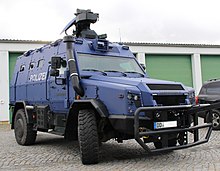SWAT vehicle

A SWAT vehicle, also known as an armoured rescue vehicle, a vehicle used by police tactical units to respond to incidents. These are often non-military armored vehicles which offer protection to the passengers and can additionally be used to transport specialized equipment such as weapons and breaching tools.
Production[]
A SWAT vehicle may simply be an unarmored van, SUV or truck used to transport equipment or officers or used as a command post. Other more specialized vehicles may be armoured personnel carriers to allow them to be in situations where armed confrontation is likely. Early versions of the SWAT vehicles were based on production vans such as the International Harvester Metro Vans.[1]
Specialized heavy-duty commercial vehicles can be up-fitted and built solely as SWAT Vehicles, such as the Ballistic Armored Tactical Transport from The Armored Group, LLC; Mesa, Arizona currently operates one of these vehicles. The Lenco BearCat is another of these such vehicles built upon a commercial Ford F550 chassis. Lenco BearCats are currently used by various agencies such as the LAPD, NYPD and Australian Police Tactical Groups.
Ambulances and armored trucks can also be converted into SWAT vans or trucks. De-militarized Armored Personnel Carriers can be used for this purpose, as is the case with the police department of Phoenix, Arizona which uses an M113 APC as part of its inventory or the Florida Highway Patrol, which has 3 Cadillac-Gage V-150s.
Around the world[]
France[]

Among other armoured vehicles, the SWAT units of the French National Police RAID and Research and Intervention Brigade (BRI) are equipped with different armoured vans.[2]
Germany[]

Armoured police vehicles were first introduced after World War I by German police forces, ho had more than hundred armoured vehicles called German: Sonderwagen (German for special wagon) . Nowadays the Federal Police and the state police forces still maintain armoured vans, like Sonderwagen 4 and Sonderwagen 5. The federal police recently also ordered the LAPV Enok in addition to its Mowag Eagle and ATF Dingo. The SEK special state police units use armored vehicles like the LAPV Enok and the Survivor R.[3][4][5]
Japan[]

Riot Police Units have been operating some series of armored buses (警備車, Keibi-sha), mainly used as mobile shelters and barriers. And in addition to them, more heavily-armored vehicles called Special Armored Vehicles (特型警備車, Tokugata-keibi-sha) were introduced in the 1960s. The first deployed model was called Type F-3, based on Mitsubishi's cab-after-engine trucks. They were initially treated as idlers because there are only few reports of gun violence in Japan, but they were highly appreciated during the Asama-Sansō incident in 1972 and their significance were widely recognized.[6]
After several model changes, Type PV-2 based on the Mitsubishi Fuso Canter is now deployed nationwide, mainly for Anti-firearms squads. There are also simplified version called Special Armored Van (特型遊撃車, Tokugata-yūgeki-sha), and much larger Heavy Special Armored Vehicle (銃器対策警備車, Jūki-taisaku-keibi-sha); the latter is dedicated to the Special Assault Teams.[6]
United Kingdom[]

Police in the United Kingdom, particularly the Police Service of Northern Ireland (PSNI), has a great number of police role armoured vehicles based upon a range of base platforms including the Land Rover Defender and the OVIK Crossway. The internal security situation in Northern Ireland demands that the police operate up to 450 armoured vehicles which are optimised for public order duties. The PSNI uses OVIK Pangolin armoured public order vehicles.
United States[]
SWAT units may also employ ARVs (Armored Rescue Vehicle[7]) for insertion, maneuvering, or during tactical operations such as the rescue of civilians, officers, firefighters, and/or military personnel pinned down by gunfire. To avoid detection by suspects during insertion in urban environments, SWAT units may also use modified buses, vans, trucks, or other seemingly normal vehicles. During the 1997 North Hollywood shootout, LAPD SWAT commandeered an armored cash-delivery truck, which they used to extract wounded civilians and officers from the raging firefight with the heavily armed bank robbers.
See also[]
References[]
- ^ THE EVOLUTION OF SWAT TEAM EQUIPMENT: FROM WWII RIFLES TO BEARCATS
- ^ (in French) https://www.prefecturedepolice.interieur.gouv.fr/layout/set/print/Nous-connaitre/Services-et-missions/Missions-de-police/La-direction-regionale-de-la-police-judiciaire/La-brigade-de-recherche-et-d-intervention. Missing or empty
|title=(help) - ^ "Nachrichten aus Hamburg". Archived from the original on 2017-11-14.
- ^ "Innenminister übergibt sondergeschütztes Gruppenfahrzeug an Spezialeinheiten".
- ^ "Polizei Sachsen - Fehler".
- ^ Jump up to: a b Kikuchi, Masayuki (June 9, 2018). テロへの備え、警察の「特型警備車」誕生の背景 [Preparing for Terrorist attacks - Background of the birth of the Special Armored Vehicles]. TrafficNews.jp (in Japanese).
- ^ "Guidelines for Armored Rescue Vehicles". 2008-01-01. Archived from the original on 2012-11-05. Retrieved 2011-01-25.
| Wikimedia Commons has media related to Police armored fighting vehicles. |
- Police vehicles
- Paramilitary vehicles
- Vans
